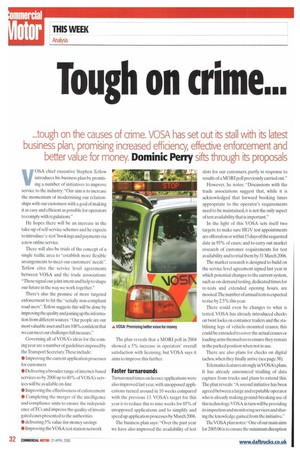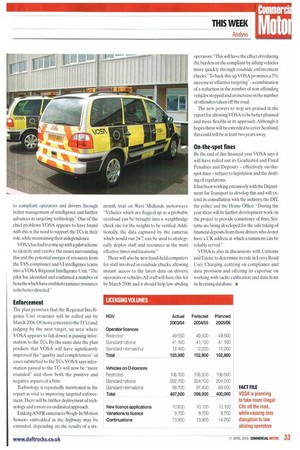Tough on crime...
Page 32

Page 33

If you've noticed an error in this article please click here to report it so we can fix it.
...tough on the causes of crime. VOSA has set out its stall with its latest business plan, promising increased efficiency, effective enforcement and better value for money. Dominic Perry sifts through its proposals
VGSA chief executive Stephen Tetlow introduces his business plan by promising a number of initiatives to improve service to the industry: "Our aim is to increase the momentum of modernising our relationships with our customers with a goal of making it as easy and efficient as possible for operators to comply with regulations."
He hopes there will be an increase in the take-up of self-service schemes and he expects to introduce 'e-test' bookings and payments via a new online service.
There will also be trials of the concept of a single traffic area to "establish more flexible arrangements to meet our customers' needs". Tetlow cites the service level agreements between VOSA and the trade associations: "These signal our joint intent and help to shape our future in the way we work together."
There's also the promise of more targeted enforcement to hit the "serially non-compliant road users". Tetlow suggests this will be done by improving the quality and joining up the information from different sources: "Our people are our most valuable asset and I am 100% confident that we can meet our challenges full measure," Governing all of VOSA's ideas for the coming year are a number of guidelines imposed by the Transport Secretary.These include: • Improving the current application processes for customers • Delivering a broader range of internet-based services so by 2008 up to 80% of VOSA's services will be available on-line • Improving the effectiveness of enforcement • Completing the merger of the intelligence and compliance units to ensure the independence of TCs and improve the quality of investigated cases presented to the authorities • delivering 5% value-for-money savings • Improving the VOSA test station network The plan reveals that a MORI poll in 2004 showed a 5% increase in operators' overall satisfaction with licensing, but VOSA says it aims to improve this further.
Faster turnarounds
Turnaround times on licence applications were also improved last year, with unopposed applications turned around in 10 weeks compared with the previous 13. VOSA's target for this year is to reduce this to nine weeks for 85% of unopposed applications and to simplify and speed up application processes by March 2006.
The business plan says: "Over the past year we have also improved the availability of test slots for our customers, partly in response to results of a MORI poll previously carried out."
However, he notes: -Discussions with the trade associations suggest that, while it is acknowledged that forward booking times appropriate to the operator's requirements need to be maintained, it is not the only aspect of test availability that is important."
In the light of this VOSA sets itself two targets: to make sure HGV test appointments are offered on or within 15 days of the requested date in 95% of cases; and to carry out market research of customer requirements for test availability and to trial them by 31 March 2006.
The market research is designed to build on the service level agreement signed last year in which potential changes to the current system, such as on-demand testing, dedicated times for re-tests and extended opening hours, are mooted.The number of annual tests is expected to rise by 2.5% this year.
There could even be changes to what is tested. VOSA has already introduced checks on twist locks on container trailers and the stabilising legs of vehicle-mounted cranes; this could be extended to cover the actual cranes or loading arms themselves to ensure they remain in the parked position when not in use.
There are also plans for checks on digital tachos, when they finally arrive (see page 38).
Telematics features strongly in VOSA's plans It has already announced trialling of data capture from trucks and plans to extend this. The plan reveals: "A second initiative has been agreed between a large and reputable operator who is already making ground-breaking use of this technology. VOSA in turn will be providing its inspection and monitoring services and sharing the knowledge gained from the initiative."
The VOSA plan notes: "One of our main aims for 2005/06 is to ensure the minimum disruption to compliant operators and drivers through better management of intelligence and further advances in targeting technology.One of the chief problems VOSA appears to have found with this is the need to support the TCs in their role, while maintaining their independence.
VOSA has had to come up with a pilot scheme to identify and resolve the issues surrounding this and the potential merger of resources from the TAN compliance and VI intelligence teams into a VOSA Regional Intelligence Unit: "The pilot has identified and confirmed a number of benefits which have enabled examiner resources to be better directed."
Enforcement
The plan promises that the Regional Intelligence Unit structure will be rolled out by March 2006. Of more concern to the TCs (and. judging by the next target, an area where VOSA appears to fall down) is passing information to the TCs. By the same date the plan predicts that VOSA will have significantly improved the "quality and completeness" of cases submitted to the TCs. VOSA says information passed to the TCs will now be "more rounded" and show both the positive and negative aspects of a firm.
Technology is repeatedly mentioned in the report as vital to improving targeted enforcement.There will be further deployment of technology and a more co-ordinated approach.
Linking ANPR cameras to Weigh-In-Motion Sensors embedded in the highway may be extended, depending on the results of a six month trial on West Midlands motorways: "Vehicles which are flagged up as a probable overload can be brought into a weighbridge check site for the weights to be verified. Additionally, the data captured by the cameras, which would run 24/7, can be used to strategically deploy staff and resources at the most effective times and locations."
There will also be new hand-held computers for staff involved in roadside checks, allowing instant access to the latest data on drivers, operators or vehicles, All staff will have this kit by March 2006, and it should help law-abiding operators: "This will have the effect of reducing the burden on the compliant by sifting vehicles more quickly through roadside enforcement checks."To back this up VOSA promises a 5% increase in 'effective targeting.a combination of a reduction in the number of non-offending vehicles stopped and an increase in the number of offenders taken off the road.
The new powers to stop are praised in the report for allowing VOSA to be better planned and more flexible in its approach. Although it hopes these will be extended to cover Scotland, this could still be at least two years away.
On-the-spot fines
By the end of this financial year VOSA says it will have rolled out its Graduated and Fixed Penalties and Deposits effectively on-thespot fines subject to legislation and the drafting of regulations.
It has been working extensively with the Department for Transport to develop this and will extend its consultation with the industry, the Da, the police and the Home Office: "During the year there will be further development work on the project to provide consistency of fines. Systems are being developed for the safe taking of financial deposits from those drivers who do not have a UK address at which a summons can be reliably served."
VOSA is also in discussions with Customs and Excise to determine its role in Lorry Road User Charging, centring on compliance and data provision and offering its expertise on working with tacho calibration and data from its licensing database. •










































































































































































































